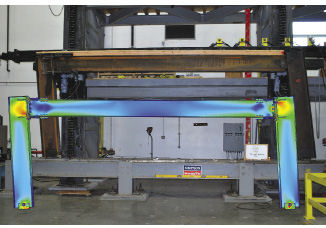Latest News
November 1, 2013
In July 2012, the open, voluntary and free UberCloud CAE Experiment got underway with the goal of provideing cloud alternatives for CAE among small and mid-sized manufacturing entities, or SMEs. This project recruited several teams that included high-performance computing (HPC) specialists, design engineers, and design and simulation software vendors. Desktop Engineering reported on this experiment (deskeng.com/articles/aabkzs.htm), as well as some of the projects that were using it in creating new designs.
Now that some of that design work has reached an advanced stage, DE is following up with a few of the participants to determine what kind of design work they did in the cloud, along with the challenges and benefits of working with cloud-based designs and simulations. We explore how they fared, including why they decided to move into the cloud, and what their challenges were in doing so.
 |  |
| UberCloud HPC Computing Cloud infrastructure was used to analyze the airflow around bicycle design iterations from Trek Bicycle using a simulation of a rider and bicycle in a wind tunnel. | |
The two companies profiled here are Trek Bicycle Corp. and Simpson Strong-Tie, two of among the 500 organizations and individuals from 48 countries that have participated in the UberCloud HPC Experiment so far. These teams consisted of an industry end user with one or more engineering design problems, and a software provider, as well as a resource provider and an HPC expert.
Trek: A Bicycle Built for New
Trek Bicycle Corp. started out with the goal of building the best bikes in the world. The company has since expanded its mission to include providing simple transportation solutions to complex problems. In the past, Trek’s designs have undergone iterative design processes including multiple prototypes and wind tunnel testing to create highly aerodynamic designs.
The UberCloud HPC Computing Cloud infrastructure was used to analyze the airflow around bicycle design iterations from Trek Bicycle. The CAPRI to OpenFOAM Connector and the Sabalcore HPC Computing Cloud infrastructure were used to analyze the airflow around bicycle design iterations. According to engineer Mio Suzuki, the project was straightforward, using the UberCloud to set up a simple simulation of bicycle and rider in the wind tunnel.
“This type of simulation is typical of the work I ran at Trek to benchmark computational fluid dynamics results to Trek’s wind tunnel data, and I used the results to guide the future design direction,” says Suzuki.
Trek didn’t have significant issues in moving to the UberCloud, Suzuki reports; in fact, it was fairly straightforward to port the simulation into the cloud. “It didn’t take a lot of effort,” she says. “I believe that’s the beauty of CAPRI software provided by CADNEXUS. The software helped to streamline the model importing process, running simulations, and getting data. I’ve been using cloud service for design/analysis for quite some time now, so I knew what to anticipate should there be any kinks in the process. And I’m always on the lookout for streamlining the process as much as possible.”
Suzuki acknowledges that the introduction to the CAPRI software was a great reminder that there are many well-thought-out products and services that can make end users’ lives much easier. For this team, though, the exposure to a greater range of tools will almost certainly be a long-term benefit to their experience and knowledge. It also gives the team and the engineering organization more options to consider in future engineering projects.
 Simpson Strong-Tie needed cloud bursting for its heavy-duty Abaqus structural analysis of physical designs. |
Suzuki says that there were several significant benefits Trek obtained by working in the cloud for these designs—not the least of which was a gain in computational speed. Trek has in-house HPC capabilities that are sufficient for small-scale runs and for testing new ideas and concepts. But large parallel computation demands additional resource power from the cloud-based system. It simply doesn’t make sense for Trek to maintain that kind of computational capability in-house.
In addition, the cloud has helped Trek’s design team diversify and accelerate the pace of aerodynamics research.
“It may not be widely known, but I think there are many aspects of aerodynamics one can observe and study with a bicycle and/or bicycle and rider,” Suzuki says. “Having additional large-scale resource means I can study these details simultaneously.”
| Is Licensing On-Demand Technology the Future? If last month’s Altair Technology Conference is any indication, the way people prefer to acquire and use engineering technology may be heading for a drastic change: “Cloud is driving the enterprise solution and new business models,” said James Scapa, chairman and CEO of Altair Engineering during his address. The Era of “What you need, when you need it” has prompted many tech companies to rethink or refine their strategy. PTC’s rebranding of the all-inclusive Pro/E as modular Creo pieces is one example. Autodesk’s swift shift to cloud-hosted and cloud-augmented products is another. Siemens’ move to industry-specific solutions and subscription model on some titles, and a industry-focused approach taken by Dassault Systèmes may also be prompted by the same trends. Perhaps the most significant product from Altair to address the changing consumer behavior is the launch of a three-pronged HyperWorks product line: HyperWorks Unlimited, HyperWorks On-Demand, and Simulation Cloud Suite. HyperWorks Unlimited, dubbed “a private cloud solution,” is high-performance computing (HPC) in a box, an appliance configurable in your desired computing core-count. The hardware is preloaded with cluster management and job queue control software. The appliance is leased, not sold. It comes with unlimited HyperWorks Units—a kind of tokens that can be used to access software from Altair and Altair partners. If your in-house clusters, workstations, or IT resources prove insufficient to tackle your simulation jobs, Altair’s HyperWorks On-Demand could be the reinforcement you call on. It’s described as “a public cloud solution,” but in terms more familiar to the on-demand industry, it may be called Platform as a Service (PaaS) or Infrastructure as a Service (IaaS). The offering gives you access to Altair’s data center to process simulation jobs. Click here for more information. —Kenneth Wong |
Simpson Strong-Tie: Moving Structural Analysis to the Cloud
Simpson Strong-Tie used the UberCloud for heavy-duty Abaqus structural analysis of physical designs. The applications used by this company range from solving anchorage tensile capacity and steel and wood connector load capacity, to special moment frame cyclic pushover analysis. The HPC cluster at Simpson Strong-Tie is modest, consisting of 32 cores. Therefore, when emergencies arise, the need for cloud bursting is critical. Also challenging is the ability to handle sudden large data transfers, as well as the need to perform visualization for ensuring that the design simulation is proceeding along correct lines.
Engineer Frank Ding from Simpson Strong-Tie led the engineering design effort on this project. In addition, there were UberCloud team members from software provider SIMULIA, a resource provider from Nimbix, and the team expert.
Simpson Strong-Tie typically uses HPC resources in solving problems involving structures designed to support frames, traffic or other structures. Ding’s particular HPC project dealt with customized concrete anchorage reinforcement design, a typical problem domain for finite element analysis (FEA).
Ding reports that there were few difficulties in moving the project over to the UberCloud. He did, however, note a couple of issues. For example, he found that “FEA result data movement is a bottleneck for the smooth cloud computing workflow.” The analysis produced so much data that getting the data on and off the cloud-based system slowed down the potential turnaround times of newer incremental designs and analysis. With higher bandwidth, this problem may have been able to be reduced or eliminated.
While the UberCloud easily brought HPC computing resources to bear on the analysis problem, Ding also identified several other actual or potential issues in his experiences. For example, while his project gained free use of the software licenses and time needed to complete the project, he notes that application software licensing for the cloud model is still in its infancy, and may make a project more expensive, depending on the computing resources required.
In addition, for many organizations looking to move to the cloud, intellectual property (IP) and security remain question marks. Concerns about protecting IP can make cloud computing a non-starter for some projects.
Still, there were also significant benefits to working in the cloud, Ding says. He identifies several significant benefits in designing and analyzing in the cloud, including:
- removal of HPC infrastructure support;
- the availability of scalable computing resources; and
- a simple pay-for-use model.
Building Better Designs
Overall, it is clear that the UberCloud experiment—and perhaps cloud-based HPC in general—isn’t a big barrier to building great designs. With appropriate tools support and HPC expertise, doing design and simulation in the cloud can be a fast and cost-effective way to bring new products to market. Even projects that aren’t using the cloud today can be migrated in a relatively short period of time.
But it’s not going to happen overnight. Engineering organizations have to understand and face tradeoffs in vendor selection, software licensing, data movement and security. Not all of these will be issues on all projects, but teams need to consider these and other potential drawbacks on a project-by-project basis.
Software plays an important role in moving to the cloud. If existing toolsets support operation in the cloud, the design team can avoid a technology learning curve. If new design and analysis tools are needed, there may be training expenses and a period of time for engineers to get up to speed on how to use the software and the results it generates.
But it’s also clear that the cloud enables engineering organizations to build better designs more quickly. Thanks to techniques such as iterative design, simulation and analysis, fewer physical prototypes have to be built. Because larger parts of the design, or even entire designs can be simulated, it can enable further refinement of designs or faster times to market.
The UberCloud project is free, and any use of a commercial HPC cloud will entail costs for computer time and software license rental or purchase. But whatever the cost, there will likely be savings over in-house HPC resources.
Contributing Editor Peter Varhol covers the HPC and IT beat for DE. His expertise is software development, math systems, and systems management. You can reach him at [email protected].
More Info
Subscribe to our FREE magazine, FREE email newsletters or both!
Latest News
About the Author
Peter VarholContributing Editor Peter Varhol covers the HPC and IT beat for Digital Engineering. His expertise is software development, math systems, and systems management. You can reach him at [email protected].
Follow DE





